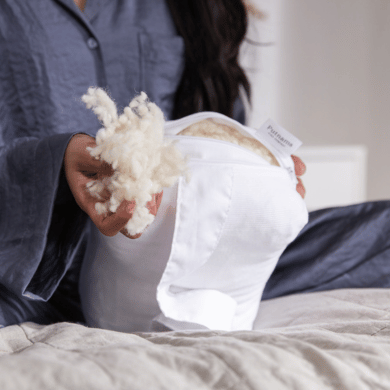
Embracing Therapeutic Laziness
If your social media feeds are anything like ours, you’ve probably noticed the rise of the “bed rotting trend.” It’s a term that describes spending long, unapologetic hours in bed, not sleeping, but simply resting. This isn't about being unproductive; it’s about intentionally embracing downtime. This movement has evolved into what trend forecasters call "therapeutic laziness," a form of self-care relaxation that pushes back against the pressure to be constantly busy.
Let's explore what therapeutic laziness is and why this wellness rest trend is gaining so much traction, but don't worry, we'll do so at a leisurely pace and feel free to take a break at any point!
We will look at the mental health benefits of switching off and offer practical ways to practise guilt-free rest. Finally, we'll suggest how the right comfort products can turn your downtime into a deeply restorative experience.
Could this be the trend all the wellness app developers don't want you to know about?
What is Therapeutic Laziness?
Therapeutic laziness is the conscious choice to rest and simplify.
It reframes intentional rest as a vital form of self-care, focusing on low-effort, high-impact rituals that support your wellbeing without demanding extra time or energy. Trend analysts at WGSN have described it as an "anti-wellness" movement that elevates the viral "bed rotting trend" into a more refined self-care ritual.
Instead of chasing complex routines, therapeutic laziness encourages you to do less. Could less really be more when it comes to regenerative wellness?
Think of it as creating a restful environment, complete with soft lighting and comforting textures, that turns downtime into a mindful, rejuvenating practice. It’s about being intentionally unproductive to recharge both mentally and physically.
Therapeutic laziness, as explained by Dr. Anil Kumar, Consultant Psychiatrist at Paras Health, Gurugram, shifts the focus from traditional self-care activities like meditation or exercise to the art of intentional rest. By simply doing nothing, this practice helps combat burnout and chronic stress, giving the nervous system a much-needed break. Embracing rest can lower stress hormones, improve sleep, and restore energy, promoting overall mental and physical well-being.
See also - Switch Off, Relax, and Embrace the Secret Art of 'Beditation'
Challenging a Culture of Constant Productivity
In our society, productivity is often linked to self-worth.
This mindset can turn self-care into another task on our to-do list, creating more stress instead of providing relief. The constant pressure to optimise every moment can lead to decision fatigue and burnout.
Therapeutic laziness challenges this notion by normalising rest.
It suggests that rest isn't something you earn after being productive; it's a biological necessity like breathing in and breathing out. By embracing downtime, you're not failing or falling behind.
Instead, you're giving your mind and body the essential break they need to function effectively. As research shows, allowing the mind to wander can enhance creativity and problem-solving skills, proving that rest is, in itself, productive.
The Mental Health Benefits of Switching Off
Choosing to embrace guilt-free rest has significant benefits for your mental wellbeing. When you intentionally slow down, you give your nervous system a break from constant stimulation, which can help regulate stress hormones like cortisol.
Here’s how therapeutic laziness can support your mental health:
- Reduces Stress and Anxiety: Engaging in periods of rest activates the parasympathetic nervous system, often called the "rest and digest" system. This helps lower cortisol levels and promotes a sense of calm.
- Improves Cognitive Function: When your brain isn't constantly processing new information, it has the space to consolidate memories, process thoughts, and generate new ideas. This can lead to improved focus and creativity when you return to your tasks.
- Prevents Burnout: By taking regular breaks, you reduce the risk of mental and physical exhaustion. Therapeutic laziness is a deliberate act of resistance against the chronic stress that leads to burnout.
- Enhances Emotional Resilience: Rest provides an opportunity for self-reflection and emotional processing. Giving yourself this space helps you gain clarity and build the resilience needed to navigate life's challenges.
See also - Screens, Sleep and the Mind: How to Unplug the Right Way Before Bed
How to Practise Guilt-Free Rest
Breaking the cycle of guilt associated with rest can be difficult, but it's a crucial step toward better wellbeing. Here are a few ways to start incorporating therapeutic laziness into your life:
- Reframe Your Mindset: Start by challenging the internal belief that rest is unproductive. Remind yourself that rest is essential for your health and performance. Affirmations like "Resting is a form of self-care" can help reinforce this new perspective.
- Schedule Your Downtime: Just as you schedule meetings and appointments, block out time in your calendar for rest. This makes it a non-negotiable part of your routine.
- Create a Restful Environment: Make your space a sanctuary for relaxation. Dim the lights, put on some soothing music, and surround yourself with comforting textures. Fresh sheets and a calm atmosphere can signal to your brain that it's time to unwind.
- Disconnect Digitally: One of the biggest obstacles to true rest is the constant ping of notifications. Put your phone on silent or in another room to give your mind a genuine break from digital distractions.
- Listen to Your Body: Pay attention to your body's signals. If you feel tired, give yourself permission to rest. Don't push through exhaustion.
Comfort That Supports Intentional Relaxation
Creating a comfortable environment is central to practising therapeutic laziness. The right products can transform your bed from just a place to sleep into a true wellness sanctuary. At Putnams, we design products that support your body and promote deep, restorative rest.
- Supportive Pillows: Whether you prefer memory foam or traditional fillings, a supportive pillow is essential for comfortable rest. Our pillows are designed to align your neck and spine, reducing strain while you relax with a book or simply lie still.
- Comfortable Bed Wedges: For those who enjoy reading or watching something in bed, a bed wedge can provide the perfect angle of support for your back and neck. It allows you to sit up comfortably without straining, making your "bed rotting" time even more enjoyable.
- Calming Bedding: The feel of your bedding can have a huge impact on your ability to relax. Our soft, breathable duvets and mattress toppers create a cosy cocoon that invites you to let go of the day's stress and sink into a state of calm.
See also - How Cushions & Pillows Can Reduce Anxiety
Frequently Asked Questions
What is the difference between therapeutic laziness and just being lazy?
Therapeutic laziness is about being intentional with your rest. It’s a conscious choice to disengage from productivity to recharge, whereas general laziness often involves avoiding tasks without a clear purpose for rest.
How do I know if I'm practising therapeutic laziness in a healthy way?
Healthy use of intentional rest leaves you feeling mentally refreshed, recharged, and ready to return to daily activities with better focus. Signs of unhealthy inactivity, however, include constant feelings of tiredness even after resting, regularly avoiding responsibilities, and a loss of interest in activities you once enjoyed.
Why is the bed rotting trend so popular?
The bed rotting trend has gained popularity, particularly among Gen Z and Millennials, as a direct response to the pressures of hustle culture. It represents a collective desire to reclaim rest and prioritise mental wellbeing without guilt. The trend has surged in popularity on platforms like TikTok, where users share their own experiences of embracing downtime.
See also - Bed rotting: why it is time to embrace your quilt – without the guilt - The Guardian
Embrace Rest as a Form of Self-Care
Therapeutic laziness isn't a passing trend; it's a necessary cultural shift toward a healthier, more balanced way of living. By embracing guilt-free rest, you're not just taking a break; you're actively investing in your long-term wellbeing, creativity, and resilience.
Particularly in this digital age, we seem to have lost the art of boredom; the ability to be alone with ourselves and our thoughts is becoming an anathema.
Ready to turn your rest into a restorative ritual? Explore our range of supportive pillows, bed wedges, and bedding designed to help you find your ultimate comfort.
Visit Putnams today and discover how to make every moment of rest truly count.
















Leave a comment